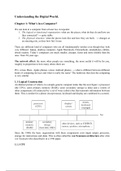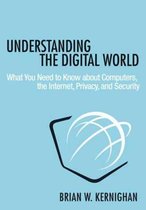Understanding the Digital World.
Chapter 1: What’s in a Computer?
We can look at a computer from at least two viewpoints:
1. The logical or functional organization: what are the pieces, what do they do and how are
they connected? → quite stable
2. The physical structure: w hat the pieces look like and how they are built. → changes at
an amazing rate, as does how fast it runs.
There are different kind of computers who are all fundamentally similar even though they look
very different: laptop, desktop computer, Apple Macintosh, Chromebook, smartphones, tablets,
ebook readers. Today’s computers are much smaller, cheaper, faster and more reliable than the
ones from 50 years ago.
The network effect: the more other people use something, the more useful it will be for you,
roughly in proportion to how many others there are.
PCs versus Macs, Apple phones versus Android phones → what is different between different
kinds of computing devices and what is really the same? The hardware that does the computing
is very similar.
1.1 Logical Construction
An abstract picture of what is in a simple generic computer looks like the next figure: a processor
(the CPU), some primary memory (RAM), some secondary storage (a disk) and a variety of
other components all connected by a set of wires called a bus that transmits information between
them. This is similar for a phone (except mouse, keyboard and display are combined in a screen).
Since the 1940s the basic organization with these components exist (input output, processor,
storage for instructions and data). This is often called the von Neumann architecture after John
von Neumann who described it in a 1946 paper.
1.1.1 CPU
,The processor or central processing unit (CPU) is the brain of the computer. It does arithmetic,
moves data around, and controls the operation of the other components. It has some basic
operations that it can perform but it does so very fast, billions per second. It can decide what
operations to perform next based on the results of previous computations.
When buying a computer device this is often described in very difficult terms “2.2 GHz
dual-core Intel Core i7 processor” Intel core is just a just marketing term. It means that is has two
processing units the “core”is now a synonym for “processor” but it is easiest to use CPU no
matter how many cores it has. The speed of the cpu is measured by the number of operations or
instructions it can do in a second. It uses an internal clock. One measure of speed is the number
of ticks per second, one beat or tick is called hertz (Hz) after Heinrich Hertz who discovered
how to produce electromagnetic radiation in 1888. Computers run in the billions of hers, or
gigahertz (GHz) so 2.2 GHz means 2,200,000,000 ticks per second (the human heartbeat is about
100,000 per day).
Mega: one million or 10^6
Giga: one billion or 10^9
Tera: one trillion or 10^12
Peta: 10^15
1.1.2 RAM
The primary memory or random access memory (RAM) stores information that is in active use
by the processor and other parts of the computer. It stores both data that the CPU is working on
and also instructions that tell the CPU what to do with the data. Result: by loading different
instructions into memory, we can make a CPU do a different computation. (REALLY
IMPORTANT! THIS IS WHY A COMPUTER CAN DO VERY DIFFERENT THING (use the
web, sent an email, go on facebook etc).
RAM is called random access memory because the CPU can access the information stored at any
place within as quickly as in any other. When you have to run all the data untill you get to the
data you need is called sequential access ( like when you want to get to the end of a videotape
and have to forward it till the end). Most ram is Volatile: its contents disappear if the power is
turned off, all the currently active information is lost (that is why you need to save your work).
Every computer has a fixed amount of RAM this is measured in bytes, a byte is an
amount of memory that’s big enough to hold a single character. More Ram usually results into
faster computing since there’s never enough for all the programs that want to use it at the same
time.
1.1.3 Disks and other secondary storage
Secondary storage holds information even when the power is turned off (not volatile). There are
two main kinds these are:
1. Hard disk or Hard drive
Magnetic disks store information by setting the direction of magnetization of tiny regions of
magnetic material on rotating metallic surfaces. Data is stored in concentric tracks that are read
,and written by a sensor that moves from track to track (the computer looks for the right place on
the disk). Disk space is about 100 times cheaper per byte than RAM, but accessing the
information is slower. It takes about ten milliseconds for the disk drive to access any particular
track on the surface; data is transferred at roughly 100 MB per second.
2. Flash memory
More and more laptops have solid state disks which uses flash memory instead of rotating
machinery. Flash memory is also non-volatile; information is stored as electric charges in
circuitry that maintains the charges in circuit elements without using any power. They can be
erased and overwritten. It is faster, lighter, more reliable, and requires less power than old disk
storage (used in cellphones, cameras for example). A typical laptop disk holds perhaps 500
gigabytes and external drives that can be plugged into a USB socket have capacities in the multi
terabyte (TB) range.
MP3 is about 1MB per minute.
Disk is a good example of the difference between logical structure or organization and physical
implementation.Organizational structure is created by hardware in the disk itself and software
in the operating system, called the file system. Physical implementation can be very different:
for example in windows disk contents organized as folders and files, but also rotating machinery,
integrated circuits or something else entirely.
Abstraction: a pervasive idea in computing: physical implementation details are hidden.
1.1.4. Et cetera
A lot of other devices serve special functions. Mice, keyboards, touchscreens, microphones,
camera all allow input. Displays, printers and speakers allow output. Wi-fi or Bluetooth
communicate with other computers. They are not connected by one bus (as it seems in the
figure) but there are multiple buses inside a computer, all with properties for their function. A
USB is an example of a bus which is not inside a computer.
The book focuses on devices that might accompany your computer or be attached to it. These
have gone through the same evolutions as processors, memory and disks: the physical properties
have changed rapidly. They are also converting into a single one, cellphones serve as watches,
calculator, photo- and video cameras, music and movie players, game consoles, barcode readers,
navigators, flashlights etc.
Phones have the same abstract architecture but they don’t have hard disks. They do have flash
memory to store information. The external devices are mostly only: bluetooth, a socket for
headphones, an external microphone, and a USB connector.
1.2 Physical construction
, Physical constructions barely change an SD card or a laptop disks form a decade old are likely to
look the same as one from today but the capacity is likely to be 10 to 100 times more. Also they
are much cheaper.
Circuit boards (printplaat) do show a lot of
progression because a lot of the components are inside a
computer nowadays, the wiring is finer and the connecting
pins are more numerous and much closer together
Electronic circuits are built from large numbers of a handful
of basic elements. The most important one is the logic gate,
which computes a single output value based on one or two
input values; it uses input signals like voltage or current to
control an output signal, also voltage or current. The
fundamental circuit element is the transistor, a device
invented in 1947 for which the inventors won the nobel
prize in 1956. A transistor is basically a switch, it can turn a current on or off under the control of
a voltage.
Logic gates are created on integrated circuits or ICS, often called chips
or microchips. An ic has all the components and wiring of an electronic circuit
on a single flat surface that is manufactured by a complex sequence of optical
and chemical processes to produce a circuit that has no discrete pieces and no
conventional wires. They are much smaller than circuitry. They are fabricated on
wafers about 30 cm in diameter and sliced in to seperate chips. ICs were
independently invented around 1958 by Robert Noyce and Jack Kilby, n obel
prize in 2000.
1.3 Moore’s Law
In 1965, Gordon Moore published a short article entitled “Cramming more components onto
integrated circuits.” He observed that more transistors could be manufactured on an integrated
circuit as technology improved, this was approximately doubling each year (later he sai 2 years
and others 18 months). This exponential growth is known as Moore’s Law. calculating that this
has been over fifty years circuits now have over a million times as many transistors as they did in
1965.
Micro: one millionth or 10^-6
Milli: one thousand or 10^-3
Nano: one billionth or 10^-9
For example a hair is about 100 micrometers or 1/10th of a millimeter thick.
Moore’s Law is not a law of nature but a guideline that the semiconductor industry has used to
set targets, at some point the law will stop working. CPU speeds no longer double every couple
of years, in part because faster chips generate too much heat, but RAM capacity still does
increase, processors can use more transistors by placing more than one CPU on a chip and often
have multiple processor chips.






